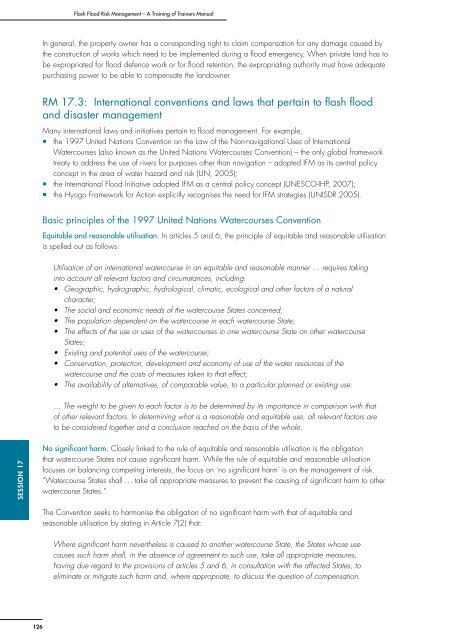Flash Flood Risk Management â A Training of Trainers ... - ReliefWeb
Flash Flood Risk Management â A Training of Trainers ... - ReliefWeb
Flash Flood Risk Management â A Training of Trainers ... - ReliefWeb
Create successful ePaper yourself
Turn your PDF publications into a flip-book with our unique Google optimized e-Paper software.
<strong>Flash</strong> <strong>Flood</strong> <strong>Risk</strong> <strong>Management</strong> – A <strong>Training</strong> <strong>of</strong> <strong>Trainers</strong> Manual<br />
In general, the property owner has a corresponding right to claim compensation for any damage caused by<br />
the construction <strong>of</strong> works which need to be implemented during a flood emergency. When private land has to<br />
be expropriated for flood defence work or for flood retention, the expropriating authority must have adequate<br />
purchasing power to be able to compensate the landowner.<br />
RM 17.3: International conventions and laws that pertain to flash flood<br />
and disaster management<br />
Many international laws and initiatives pertain to flood management. For example,<br />
• the 1997 United Nations Convention on the Law <strong>of</strong> the Non-navigational Uses <strong>of</strong> International<br />
Watercourses (also known as the United Nations Watercourses Convention) – the only global framework<br />
treaty to address the use <strong>of</strong> rivers for purposes other than navigation – adopted IFM as its central policy<br />
concept in the area <strong>of</strong> water hazard and risk (UN, 2005);<br />
• the International <strong>Flood</strong> Initiative adopted IFM as a central policy concept (UNESCO-IHP, 2007);<br />
• the Hyogo Framework for Action explicitly recognises the need for IFM strategies (UNISDR 2005).<br />
Basic principles <strong>of</strong> the 1997 United Nations Watercourses Convention<br />
Equitable and reasonable utilisation. In articles 5 and 6, the principle <strong>of</strong> equitable and reasonable utilisation<br />
is spelled out as follows:<br />
Utilisation <strong>of</strong> an international watercourse in an equitable and reasonable manner … requires taking<br />
into account all relevant factors and circumstances, including:<br />
• Geographic, hydrographic, hydrological, climatic, ecological and other factors <strong>of</strong> a natural<br />
character;<br />
• The social and economic needs <strong>of</strong> the watercourse States concerned;<br />
• The population dependent on the watercourse in each watercourse State;<br />
• The effects <strong>of</strong> the use or uses <strong>of</strong> the watercourses in one watercourse State on other watercourse<br />
States;<br />
• Existing and potential uses <strong>of</strong> the watercourse;<br />
• Conservation, protection, development and economy <strong>of</strong> use <strong>of</strong> the water resources <strong>of</strong> the<br />
watercourse and the costs <strong>of</strong> measures taken to that effect;<br />
• The availability <strong>of</strong> alternatives, <strong>of</strong> comparable value, to a particular planned or existing use.<br />
… The weight to be given to each factor is to be determined by its importance in comparison with that<br />
<strong>of</strong> other relevant factors. In determining what is a reasonable and equitable use, all relevant factors are<br />
to be considered together and a conclusion reached on the basis <strong>of</strong> the whole.<br />
session 17<br />
No significant harm. Closely linked to the rule <strong>of</strong> equitable and reasonable utilisation is the obligation<br />
that watercourse States not cause significant harm. While the rule <strong>of</strong> equitable and reasonable utilisation<br />
focuses on balancing competing interests, the focus on ‘no significant harm’ is on the management <strong>of</strong> risk.<br />
“Watercourse States shall … take all appropriate measures to prevent the causing <strong>of</strong> significant harm to other<br />
watercourse States.”<br />
The Convention seeks to harmonise the obligation <strong>of</strong> no significant harm with that <strong>of</strong> equitable and<br />
reasonable utilisation by stating in Article 7(2) that:<br />
Where significant harm nevertheless is caused to another watercourse State, the States whose use<br />
causes such harm shall, in the absence <strong>of</strong> agreement to such use, take all appropriate measures,<br />
having due regard to the provisions <strong>of</strong> articles 5 and 6, in consultation with the affected States, to<br />
eliminate or mitigate such harm and, where appropriate, to discuss the question <strong>of</strong> compensation.<br />
126

















